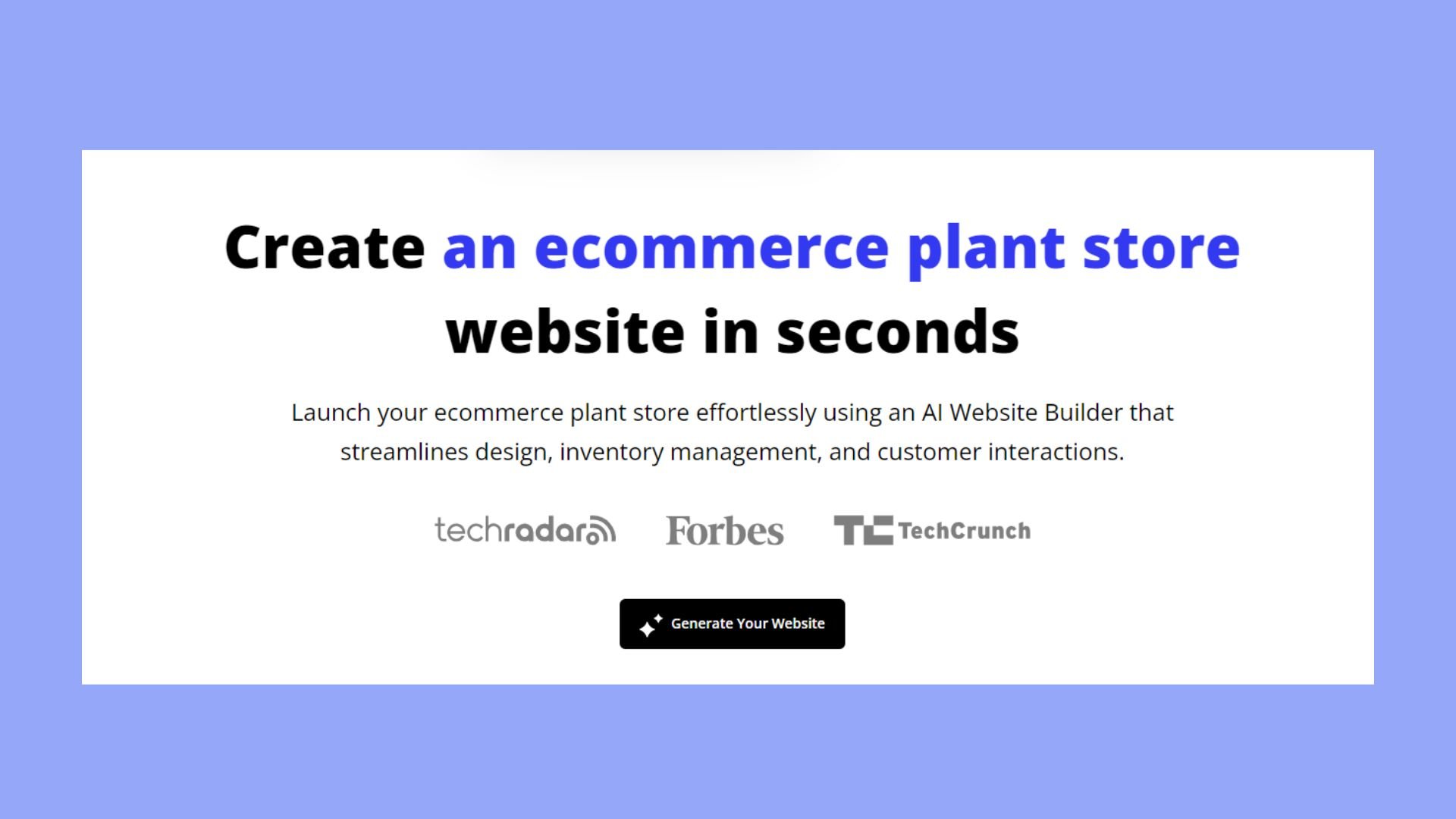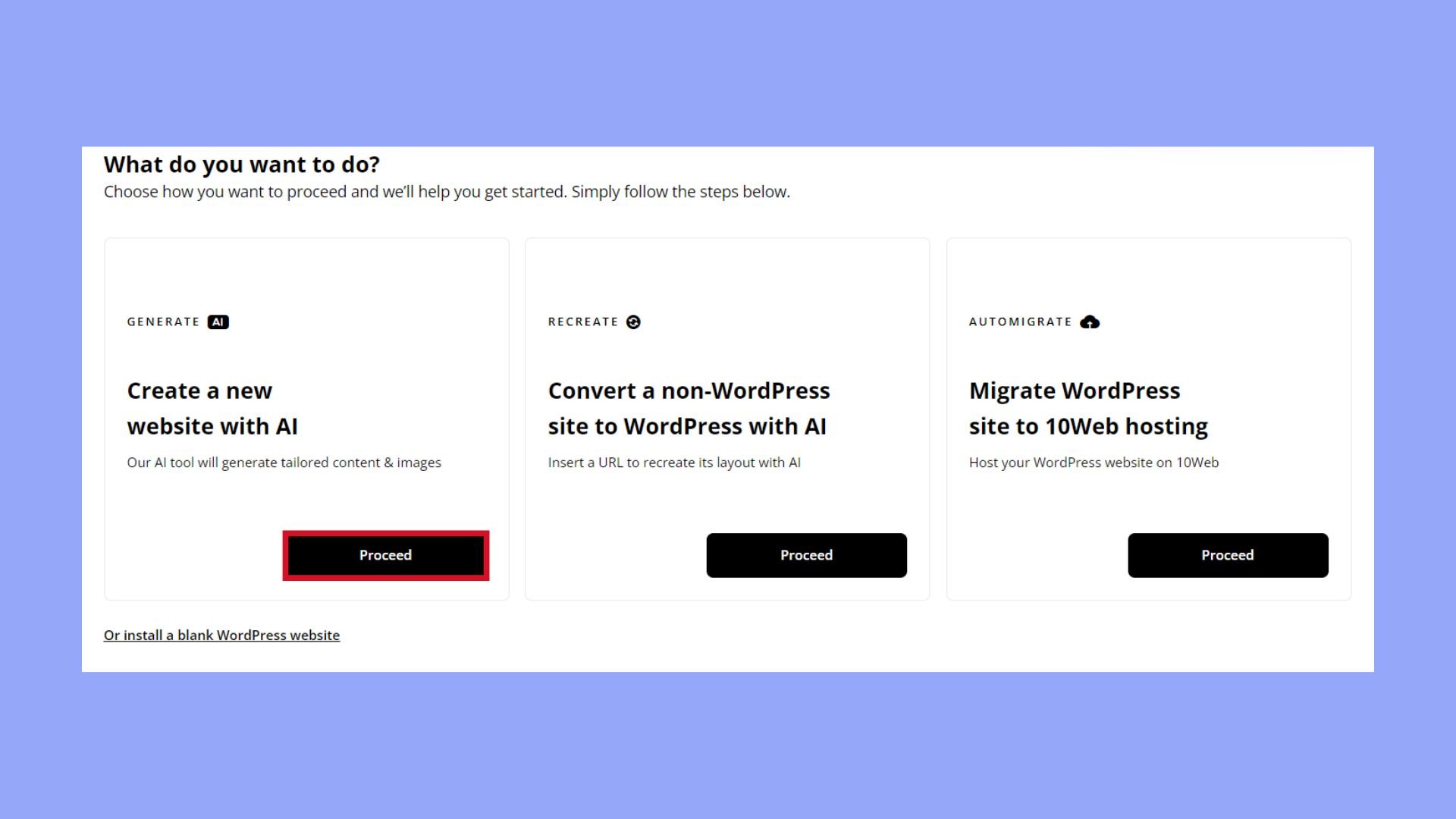Starting a plant business opens up a world of exciting opportunities for those with a passion for gardening and a love for greenery. Whether you’re dreaming of a cozy home nursery or a bustling online store, the potential to turn your green thumb into a profitable venture is immense. In this section, we’ll explore the key steps and strategies on how to start a plant business, from setting up your sales structure to maximizing marketing efforts. Get ready to embark on a journey that blends the joy of nurturing plants with the excitement of growing a successful business.
FAQ
How profitable is a plant business? How can I start my own plant business? Can I sell plants I grow at home? Is selling plants a good side hustle?

Looking to sell online?
Create your custom online store in minutes with 10Web AI Ecommerce Website Builder and take your business online.
Stage 1: Plant business essentials
Planning is key to starting a successful plant business. You need to write a business plan, research your market, understand the competition and set up your legal framework. This will help you stay on track and grow your plant business effectively.

Step 1: Writing a business plan
A business plan serves as a roadmap for your plant business. Start with an executive summary, which provides a brief overview of your business. Include details about your mission, vision, and core values. Outline your products or services, such as plants, seeds, gardening supplies, or consultation services.
Next, include a marketing plan that describes how you will attract customers. This might involve social media marketing, local advertising, or partnerships with local garden centers. Additionally, plan your financials, including projected income, expenses, and funding needs. Finally, describe your business structure (e.g., LLC, corporation) and obtain necessary legal documents like a business license and EIN (Employer Identification Number).
Setting your business goals
Clear goals guide your progress. Start by setting short-term goals, such as gaining your first set of customers or growing a specific number of plants within three months. Long-term goals might include expanding your nursery, diversifying your plant selection, or reaching a certain revenue milestone.
Make sure your goals are SMART – Specific, Measurable, Achievable, Relevant, and Time-bound. For example, “Increase sales by 20% within six months” is a SMART goal. Regularly review your goals and adjust them as needed based on your business performance.
Step 2: Understanding your market
To stand out in the plant business, understand your market. Market analysis is essential. Identify your target customers—homeowners, garden enthusiasts, or businesses needing landscaping services. Research your competitors to learn about their strengths and weaknesses.
Consider what types of plants are popular in your area. Some plants, like native species, may have higher demand. Look for gaps in the market, such as rare or exotic plants, that you can fill. Always keep an eye on trends and customer preferences. This knowledge will help shape your product offerings and marketing strategies.
Step 3: Analyzing the competition
To build a thriving plant business, you need to understand your competitors and how to stand out from them. Here’s a closer look at local market trends and how to differentiate your business.
Researching local market trends helps you understand what types of plants are in demand in your area. Visit local nurseries, garden centers, and farmer’s markets. Take note of the popular plants they offer. Engage with customers to learn what they like or need.
Check online reviews and social media for feedback on local nurseries. This will give you insight into customer preferences and common complaints. Observe business hours and pricing strategies to understand what works best in your local market.
Differentiating your business
To stand out in a competitive market, you need unique selling points. Offer rare or specialty plants that aren’t common in your area. Consider organic or eco-friendly practices to attract environmentally conscious customers.
Provide excellent customer service and create a welcoming atmosphere. Engage with your community through events or workshops on plant care. Offering personalized advice can make your business memorable.
Consider an online presence with a user-friendly website to reach a broader audience. Highlighting customer testimonials and using high-quality photos can enhance your online appeal. This approach can set you apart and attract more customers.
Step 4: Legal and financial considerations
Starting a plant business requires attention to various legal and financial details. You will need to secure capital, open a business bank account, and ensure you have proper insurance and liability coverage.
Securing capital
To start your plant business, you will need money. You can get this money in several ways:
- Personal savings: Use your own money to start.
- Loans: Borrow money from a bank or other lenders.
- Investors: Find people who want to invest in your business.
- Grants: Look for grants that might be available for small businesses.
Each option has its pros and cons. It’s crucial to consider the terms and conditions of loans and the level of control investors might expect. Creating a budget helps you figure out how much capital you need and how you’ll use it.
Opening a business bank account
A business bank account is essential for keeping your personal and business finances separate. This can make things easier during tax time and help you manage your money better.
- Choose a bank: Look for banks offering business accounts with low fees and good services.
- Gather documents: Usually, you need your business license, EIN (Employer Identification Number), and personal ID.
- Open the account: Go to the bank or visit their website to open your account.
Having a separate bank account also helps to build a professional image. It makes it easier to track your expenses and earnings.
Insurance and liability
Insurance protects your business from unexpected problems. You will need various types of insurance:
- General liability insurance: Covers accidents and damages.
- Property insurance: Covers your business property and equipment.
- Workers’ compensation insurance: If you hire employees, this covers injuries at work.
There are many companies that offer insurance for small business owners. Get quotes from multiple providers to find the best price and coverage. Make sure you comply with local regulations to avoid legal issues.
Pay attention to licenses and other legal requirements in your area, as these can vary. Having all necessary permits and insurance secures your business against potential setbacks.
Understanding these legal and financial considerations is a key step in knowing how to start a plant business successfully.
Create your custom online store in minutes with 10Web AI Ecommerce Website Builder and take your business online. 
Looking to sell online?
Stage 2: Setting up operations
In this stage, we’ll dive into the essential steps to ensure your plant business thrives from the ground up. From choosing the perfect location and building your nursery infrastructure to sourcing plants and managing day-to-day operations, we’ve got you covered. Now, let’s explore how to bring your plant business vision to life.

Step 1: Choosing your location
Selecting the right location for your plant business is crucial. You need to consider factors such as the quality of the soil and whether to lease or buy the land.
When choosing a location, first look at the size of the space. Ensure it meets your needs for planting, storage, and expansion. Check the soil quality by testing for nutrients and pH levels. Good soil should have a balance of nitrogen, phosphorus, and potassium.
Visit multiple sites and inspect the soil personally. You can also hire experts for soil testing. Good water drainage is critical to prevent plant diseases. Ensure that the site has access to water for irrigation. High-quality soil and proper space can help your plants thrive.
Lease vs. purchase
Deciding whether to lease or purchase land depends on your long-term goals. Leasing might be more affordable initially and offers flexibility. This can be ideal if you’re testing different locations or are just starting out.
If you purchase land, you gain full control over the property. This includes the ability to make permanent changes. While more expensive upfront, owning your land can be a good investment for a well-established plant business.
Consider the length of the lease agreements and any renewal clauses. Evaluate the overall cost, including taxes and maintenance. Whether you lease or buy should align with your business goals and financial situation.
Step 2: Building your nursery infrastructure
Creating a strong foundation is essential for your plant nursery. You’ll need the right greenhouses and equipment to ensure your plants thrive and your business grows.
- Greenhouses: These structures protect your plants from harsh weather and pests. Choose a greenhouse that suits your climate and plant types. Options include hoop houses, gothic arch greenhouses, and A-frame greenhouses.
- Equipment: Invest in quality tools such as hoses, watering cans, and tractors. Reliable watering systems help maintain plant health. Additionally, you’ll need potting benches, pruners, and planting trays. Remember to consider the size of your nursery and the specific needs of your plants when selecting equipment.
Setting up a proper infrastructure ensures that your nursery business will thrive from the beginning.
Step 3: Sourcing and growing plants
When starting a plant business, it’s crucial to find reliable suppliers and master plant propagation techniques. By following these steps, you can ensure that your nursery has a steady supply of healthy plants.
Finding reliable suppliers
- Research suppliers: Start by looking for suppliers who specialize in nursery stock, seeds, and cuttings. Check online directories, attend trade shows, and join gardening forums for recommendations.
- Verify quality: Request samples of their stock to inspect quality. Healthy plants should be free from pests, diseases, and show strong root systems.
- Compare prices: Get quotes from multiple suppliers to find competitive pricing, but don’t sacrifice quality for cost. Bulk orders might get you a better deal.
- Read reviews: Look for reviews from other nursery owners. Positive feedback usually indicates reliability, while negative reviews can help you avoid potential issues.
Plant propagation techniques
- Seed propagation: Some plants grow well from seeds. Make sure you have quality potting soil and the right conditions for germination. Follow the instructions on seed packets for optimal growth.
- Cuttings: For many plants, you can use cuttings. Choose healthy mother plants and cut just below a node. Stick the cuttings in moist potting soil and use rooting hormones to boost success rates.
- Division: Certain plants, like perennials, thrive when divided. Dig up the plant, split the root ball, and replant the sections. This method can rejuvenate older plants and increase your stock.
- Grafting: For some fruit trees and ornamental plants, grafting allows you to combine qualities of two plants. It requires precision but can yield amazing results.
Regularly monitor your plants and use the right fertilizers to ensure healthy growth. By focusing on sourcing and propagation, you’ll have a thriving nursery.
Step 4: Managing operations
Effective management of operations ensures a smooth workflow, maximizes profits, and maintains high-quality standards in your plant business. Key areas to focus on include inventory management and supply chain coordination.
Inventory and stock maintenance
Maintaining your inventory is crucial for seamless operations. Regularly track all plants, supplies, and equipment. Use inventory management software to monitor stock levels and predict future needs. This helps avoid overstocking or running out of popular items.
Label each plant type clearly and group similar items together. Weekly checks can help you assess the health and status of your plants. Involve your staff in these checks to optimize the process. Make use of inventory tracking tools and set up automated reminders for reordering supplies. A well-maintained inventory ensures that you can meet customer demands promptly.
Supply chain management
Streamlining your supply chain is vital for efficiency. Build relationships with reliable suppliers to ensure timely delivery of quality materials. Negotiate contracts to secure the best prices and terms. Regularly review supplier performance to avoid disruptions.
Create a clear process for receiving and inspecting deliveries. Train your staff to handle supplies properly to maintain their quality. Use a supply chain management system to track orders, manage vendors, and forecast demand. Efficient supply chain management helps your plant business run smoothly and reduces operational costs.
By mastering these areas, you can effectively manage your plant business and ensure long-term success.
Create your custom online store in minutes with 10Web AI Ecommerce Website Builder and take your business online. 
Looking to sell online?
Stage 3: Marketing and selling your plants
Step 1: Setting up your sales structure
To successfully sell plants, you need to choose between retail or wholesale, explore ecommerce opportunities, and build a user-friendly website. These steps will help you attract and retain customers, whether you’re running a small plant shop or a larger nursery.
Retail vs. wholesale
When starting your plant business, decide if you’ll sell directly to customers (retail) or in large quantities to garden centers and other businesses (wholesale).
Retail involves setting up a physical or online plant shop. Here, you can interact directly with plant lovers. Retail prices are higher, but you need more effort in customer service and marketing.
Wholesale sales are typically larger and to garden centers or landscape companies. You will need a good inventory and efficient production methods. While the profit per plant might be lower, wholesale can provide steady income if you build strong relationships with buyers.
Ecommerce opportunities
Selling plants online opens up many possibilities for growing your business. You can reach customers far beyond your local area, expanding your market.
Start by researching different platforms like Etsy, Amazon, or your own website. Each has its own setup requirements and fees, so choose one that fits your budget and needs.
Consider logistics like shipping, which is crucial when dealing with live plants. Use secure packaging to protect the plants during transit and track deliveries to ensure they arrive on time. Offering various shipping options can attract more customers.
Building your website with 10Web
Your plant website is a crucial part of your ecommerce strategy. In this section, we will guide you through the steps to launch your plant business website using 10Web, ensuring you have a professional and attractive site ready in minutes.
- Go to 10Web.io.
- Click on Generate your website.

- Choose Create a new website with AI.

- Select Plant Business as your business type.

- Fill in the name of your business and a short description, which you can enhance using AI.

- Choose Yes to get a domain or click No if you already have one, and click Next.
- Enter your domain name if you chose No (optional)
- Set the main services and categories. This section is pre-filled by AI, but you can edit it as needed.
- Click Generate to create your website

Create your custom online store in minutes with 10Web AI Ecommerce Website Builder and take your business online. 
Looking to sell online?
By following these steps, you’ll have a website that attracts and retains customers, helping your plant business thrive online.
Step 2: Marketing your plant business
Effective marketing is crucial in making your plant business stand out. From having a strong brand to utilizing social media, several strategies can help you reach your target audience.
Branding and business cards
Create a memorable brand for your plant business. Choose a catchy name, design a creative logo, and use colors that reflect your business. Your brand should convey what makes your plant nursery unique.
Print professional business cards. This helps in building trust and making a lasting impression. Include your logo, business name, contact information, and website. Hand them out at local events, markets, and even plant shops.
Consistent branding across all materials ensures people remember you. This familiarity can turn curious visitors into loyal customers.
Social media and online advertising
Increase your reach with social media. Platforms like Instagram, Facebook, and Pinterest are perfect for showcasing your plants.
Post high-quality photos and videos of your products. Share tips on plant care to engage your audience. Use relevant hashtags to reach plant lovers.
Invest in online ads. Facebook Ads and Google Ads allow you to target specific demographics. This narrows down your audience to those most likely to buy. Be sure to track your campaign performance to see what works best.
Engage with followers by responding to comments and messages promptly. This personal touch can boost customer loyalty.
Local marketing strategies
Don’t overlook local marketing methods. Flyers and posters in community centers, coffee shops, and local businesses can attract nearby customers.
Participate in local farmer’s markets or community events. This provides a chance to connect with your community and get immediate feedback on your products.
Offering workshops on topics like plant care, potting techniques, or seasonal gardening can also attract interested individuals. This not only markets your plants but positions you as an expert in the field.
Networking with local businesses, like cafes or florists, for partnerships can further extend your reach. They may display your business cards or give away your flyers, leading to more visibility.
Focus on building a reliable local presence. Word-of-mouth is a powerful tool in growing your customer base.
Step 3: Sales and customer service
Building a successful plant business requires excellent sales strategies and top-notch customer service. These efforts can lead to loyal customers and steady revenue.
Training your team
Training your staff is essential for providing great customer service. Employees should be knowledgeable about plant care, sales techniques, and effective communication. A comprehensive training program might include:
- Plant care basics: Teach your team about watering, sunlight needs, and common plant issues.
- Customer interactions: Role-play different scenarios to improve communication skills.
- Sales techniques: Train employees on upselling, cross-selling, and handling objections.
Proper training helps ensure your staff can assist customers efficiently, enhancing the overall experience.
Developing revenue streams
Diversify your revenue through various streams to maximize profits. Here are some effective strategies:
- Selling plants: Offer a mix of common and specialty plants to attract different customer segments.
- Workshops and classes: Host events that teach customers about plant care, which can boost sales of related products.
- Online sales: Create an online store to reach a broader audience.
Combining these streams can help stabilize your income and grow your plant business steadily.
Step 4: Networking and partnerships
Building strong connections can significantly boost the success of your plant business. Working with landscapers and local community events can expand your reach and customer base.
Collaborating with landscapers
Connecting with landscapers can lead to steady business opportunities. Landscapers often need a reliable source for plants, and partnering with them can provide you with regular orders.
- Identify potential partners: Look for landscaping businesses in your area.
- Reach out: Contact them via email or phone and introduce yourself.
- Showcase your plants: Invite them to visit your nursery or send samples.
- Offer discounts: Provide special rates for bulk purchases.
- Maintain relationships: Regularly touch base and ensure timely deliveries.
By being a dependable supplier, you’ll foster long-term relationships.
Engaging with the community
Engaging with your local community is a great way to garner support and attract customers. Being active in community events helps you gain visibility.
- Participate in local events: Set up stalls at farmers markets, fairs, or gardening events.
- Partner with small businesses: Collaborate with local stores to display and sell your plants.
- Host workshops: Offer gardening classes or plant care workshops to teach and connect with potential customers.
- Social media presence: Use platforms like Facebook and Instagram to promote your business and events.
- Community projects: Take part in or sponsor community gardening projects.
Being a visible and active part of the community can enhance your reputation and customer loyalty. This will also spread word-of-mouth recommendations, boosting your plant business’s visibility.
Conclusion
Starting a plant business offers exciting opportunities to turn your passion for plants into a profitable venture. By understanding the essentials of how to start a plant business, including choosing the right sales structure, exploring ecommerce opportunities, and building a strong online presence, you can set a solid foundation for success. With careful planning, effective marketing, and dedication to quality and customer service, your plant business can thrive and grow. Embrace the journey and enjoy the rewarding process of nurturing both your plants and your business.



















